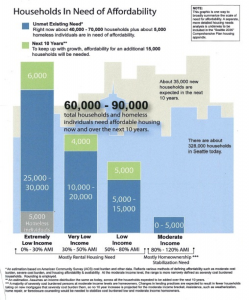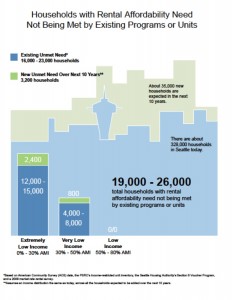Grand Bargain: City Responds to 10 Questions (Sort of)
Last week I received an e-mail response from Robert Feldstein, Director of the City’s Office of Policy and Innovation, in response to the letter I sent asking 10 questions about the so called Grand Bargain being offered as a solution to Seattle’s housing issues. My reaction varied over the hours from annoyance that the response seemed a bit canned–explaining the motivation behind the Bargain is if emphasizing the motives would make me stop and say, “Oh, right, this is a partnership!”–to sympathy since, after all, making the Bargain work, even if we were a party to it, is not going to be easy practically or politically for City staff. I responded a day and a half later mostly to clarify and dispute some of the assumptions in Fedstein’s reply as a way of setting the stage for what we hope are further discussions. Here’s the full text of the e-mail and my e-mailed response.
December 23, 2015 at 9:02 AM
Dear Roger,
I am writing in response to your letter to Mayor Murray dated December 14, 2015. Thank you for your interest in the Mandatory Housing Affordability programs and the details of implementation. The ‘Grand Bargain’ represents a significant body of work that city staff are diligently working on to meet our goal of full implementation by September 2017.
The HALA agenda is a multi-pronged approach to deliver more housing across the housing spectrum, including the streamlining of city codes and processes to better facilitate quality housing development. Indeed, one aspect of the HALA effort is to work toward increased housing supply to accommodate our city’s growth, evidenced by the inclusion of a market-rate target in our 50,000 unit goal and the commitment to increase the efficiency of the city’s processes for all development.
However, addressing the housing affordability crisis is not just about adding more housing capacity. In a city with more than 2,800 people are experiencing homelessness and sleeping outside and more than 45,000 households are spending over half their income on housing costs, there is a shared responsibility between the City, residents, businesses, nonprofits and developers to support construction and preservation of affordable housing. Growth and new development must also contribute to our affordable housing stock. The “Grand Bargain” gets us there by moving away from the previous Linkage Fee proposals and toward an acknowledgement of this partnership. The program is being developed so there is both a requirement for contribution to affordable housing and additional development capacity. In early 2016, we will begin a citywide conversation about how to implement these zoning changes equitably across the city to meet our goals.
We would be happy to meet with you to discuss the variety of questions that you have posed in your letter. Please let me know who you would like to bring to the conversation and I will work with our staff to find some time after the holidays.
Sincerely,
Robert
—————————————-
December 24, 2015 at 2:07 PM
Hello Robert and Happy Holidays,
Thank you for your response. We do appreciate it.
Let me emphasize something clearly and up front: we were not a signer of the Grand Bargain. While we want to collaborate as you suggest, up till now, the City’s record on collaboration with builders and developers is very bad. We can point to many examples of occasions when we’ve offered data and even project level pro forma financials to show why a legislative or other regulatory proposal would translate into higher costs and higher prices for buyers and renters of housing. Yet those efforts, sometimes weeks long participation in City process, yielded exactly what asked the City not to do. And, yes, costs and production are affecting the market and will translate into higher costs — even for housing built by non-profits since they are subject to all this same regulations.
As I have pointed out in various meetings, all of these regulatory initiatives proposed and implemented by City, usually at the request of people already living here, won’t stop the development and building of housing as long as there is demand. But contrary to what is often suggested, that isn’t because of profit motive; it’s because as the City dials up costs and dials down supply, rents and housing price will continue to go up which will rationalize investment by banks, lenders, and other equity sources like pension funds to build in our city. As much as some at the City would like to carve out profits for solving a problem, in the end, the people that pay for efforts to make private developers “contribute” will be those looking for housing who will find it scarce, expensive, and located inconveniently.
You simply cannot just dismiss this reality and our stating it as intransigence on our part.
What I would ask is that if the City truly wants a “partnership” it must involve everyone who is building and financing housing, not just non-profits and high rise developers that build in Downtown and South Lake Union. Additionally, we have yet to see any “streamlining of city codes and processes to better facilitate quality housing development.” In fact, we’ve seen just the opposite (e.g. legislation passed earlier this year that requires projects in abutting lots to go through design review even though the second project is itself below the design review threshold). And we’ve challenged the number you suggest of households in need using your own methodology and data and found far fewer house holds that you’re suggesting (see below).




